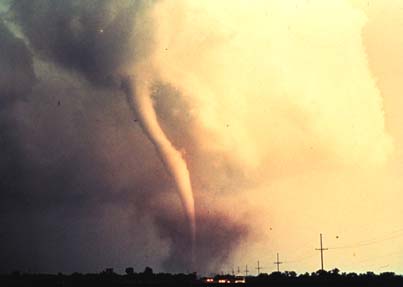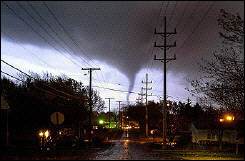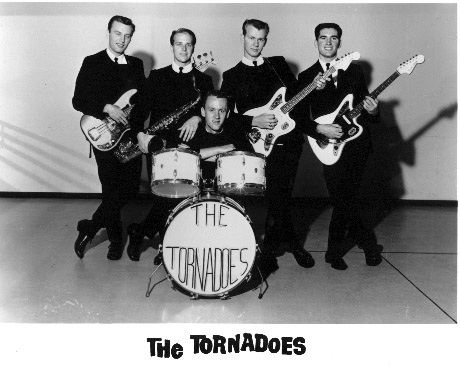
Tornadoes are nature's most violent storms. Spawned from powerful thunderstorms, tornadoes can cause fatalities and devastate a neighborhood in seconds. A tornado appears as a rotating, funnel-shaped cloud that extends from a thunderstorm to the ground with whirling winds that can reach 300 miles per hour. Damage paths can be in excess of one mile wide and 50 miles long. Every state is at some risk from this hazard.
Some tornadoes are clearly visible, while rain or nearby low-hanging clouds obscure others. Occasionally, tornadoes develop so rapidly that little, if any, advance warning is possible.
Before a tornado hits, the wind may die down and the air may become very still. A cloud of debris can mark the location of a tornado even if a funnel is not visible. Tornadoes generally occur near the trailing edge of a thunderstorm. It is not uncommon to see clear, sunlit skies behind a tornado.
Facts About Tornadoes
- They may strike quickly, with little or no warning.
- They may appear nearly transparent until dust and debris are picked up or a cloud forms in the funnel.
- The average tornado moves Southwest to Northeast, but tornadoes have been known to move in any direction.
- The average forward speed of a tornado is 30 MPH, but may vary from stationary to 70 MPH.
- Tornadoes can accompany tropical storms and hurricanes as they move onto land.
- Waterspouts are tornadoes that form over water.
- Tornadoes are most frequently reported east of the Rocky Mountains during spring and summer months.
- Peak tornado season in the southern states is March through May; in the northern states, it is late spring through early summer.
- Tornadoes are most likely to occur between 3 p.m. and 9 p.m., but can occur at any time.
Familiarize yourself with these terms to help identify a tornado hazard:
- Tornado Watch Tornadoes are possible. Remain alert for approaching storms. Watch the sky and stay tuned to NOAA Weather Radio, commercial radio, or television for information.
- Tornado Warning A tornado has been sighted or indicated by weather radar. Take shelter immediately.
Take Protective Measures
Before a Tornado
Be alert to changing weather conditions.
- Listen to NOAA Weather Radio or to commercial radio or television newscasts for the latest information.
- Look for approaching storms.
- Look for the following danger signs:
- Dark, often greenish sky
- Large hail
- A large, dark, low-lying cloud (particularly if rotating)
- Loud roar, similar to a freight train.
If you see approaching storms or any of the danger signs, be prepared to take shelter immediately.
During a Tornado
If you are under a tornado WARNING, seek shelter immediately!

What to do if you are in a structure:
(e.g. residence, small building, school, nursing home, hospital, factory, shopping center, high-rise building)
- Go to a pre-designated shelter area such as a safe room, basement, storm cellar, or the lowest building level.
- If there is no basement, go to the center of an interior room on the lowest level (closet, interior hallway) away from corners, windows, doors, and outside walls.
- Put as many walls as possible between you and the outside.
- Get under a sturdy table and use your arms to protect your head and neck.
- Do not open windows.
What to do if you are in a vehicle, trailer, or mobile home:
- Get out immediately and go to the lowest floor of a sturdy, nearby building or a storm shelter.
- Mobile homes, even if tied down, offer little protection from tornadoes.
What to do if you are outside with no shelter:
- Lie flat in a nearby ditch or depression and cover your head with your hands. Be aware of the potential for flooding.
- Do not get under an overpass or bridge. You are safer in a low, flat location.
- Never try to outrun a tornado in urban or congested areas in a car or truck. Instead, leave the vehicle immediately for safe shelter.
- Watch out for flying debris. Flying debris from tornadoes causes most fatalities and injuries.
Preparing a Safe Room
Extreme windstorms in many parts of the country pose a serious threat to buildings and their occupants. Your residence may be built to code, but that does not mean it can withstand winds from extreme events such as tornadoes and major hurricanes. The purpose of a safe room or a wind shelter is to provide a space where you and your family can seek refuge that provides a high level of protection. You can build a safe room in one of several places in your home.
- Your basement.
- Atop a concrete slab-on-grade foundation or garage floor.
- An interior room on the first floor.
Safe rooms built below ground level provide the greatest protection, but a safe room built in a first-floor interior room also can provide the necessary protection. Below-ground safe rooms must be designed to avoid accumulating water during the heavy rains that often accompany severe windstorms.
To protect its occupants, a safe room must be built to withstand high winds and flying debris, even if the rest of the residence is severely damaged or destroyed. Consider the following when building a safe room:
- The safe room must be adequately anchored to resist overturning and uplift.
- The walls, ceiling, and door of the shelter must withstand wind pressure and resist penetration by wind-borne objects and falling debris.
- The connections between all parts of the safe room must be strong enough to resist the wind.
- Sections of either interior or exterior residence walls that are used as walls of the safe room, must be separated from the structure of the residence so that damage to the residence will not cause damage to the safe room.

Additional information about Safe Rooms available from FEMA:
Taking Shelter from the Storm: Building a Safe Room Inside Your House. L-233. Brochure providing details about obtaining information about how to build a wind-safe room to withstand tornado, hurricane, and other high winds.
Taking Shelter from the Storm: Building a Safe Room Inside Your House. FEMA-320. Manual with detailed information about how to build a wind-safe room to withstand tornado, hurricane, and other high winds.
For More Information
If you require more information about any of these topics, the following are resources that may be helpful.
FEMA Publications:
Tornado Fact Sheet. L-148. Provides safety tips for before, during, and after a tornado
Tornado Protection - Selecting Refuge Areas in Buildings. FEMA 431. Intended primarily to help building administrators, architects, and engineers select the best available refuge areas in existing schools
 Print
Print Email
Email







